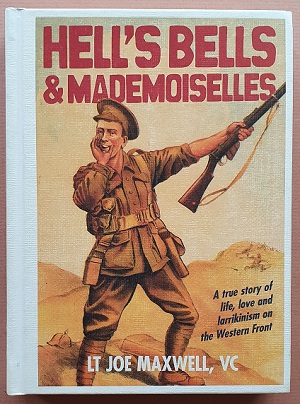Description
Title: Hell’s Bells and Mademoiselles
Author: Maxwell, Joseph VC, MC, DCM
Condition: Mint
Edition: Revised Edition
Publication Date: 2012
ISBN: 9780732296650
Cover: Hard Cover without Dust Jacket – 271 pages
Comments: Hell’s Bells and Mademoiselles is the rollicking eyewitness account of the role of 18th Battalion AIF in the First World War by one of its most decorated soldiers, the irrepressible Joe Maxwell.
Maxwell served at Gallipoli before being transferred to the Western Front. In just twelve months during 1917-1918 he was commissioned and awarded the DCM, Military Cross and Bar, and VC.
This colourful memoir is a unique record of life as a World War One digger: Joe was in most of the major battles of the Western Front and graphically describes the action he saw, as well as the notorious larrikinism -and romantic adventures-of the off-duty diggers.
Often described as Australia’s second most decorated soldier of the First World War, Joe Maxwell enlisted in the Australian Imperial Force on 8 February 1915 and served at Gallipoli before being transferred to the Western Front. In just over twelve months he was commissioned and decorated four times for his bravery. He was just 22 at the end of the war. An apprentice boilermaker before the war, Maxwell returned to Australia in 1919 and worked variously as a gardener and journalist. In 1932 Angus & Robertson published his colourful, bestselling autobiography about his war experiences, Hell’s Bells and Mademoiselles, written in collaboration with Hugh Buggy. This hugely entertaining memoir has been long out of print and is highly sought after.
The 18th Battalion was raised at Liverpool in New South Wales in March 1915 as part of the 5th Brigade. It left Australia in early May, trained in Egypt from mid-June until mid-August, and on 22 August landed at ANZAC Cove.
The battalion had not been ashore a day when it was committed to the last operation of the August Offensive – the attack on Hill 60 – which lasted until 29 August and cost it 50 per cent casualties. For the rest of the campaign the 18th played a purely defensive role, being primarily responsible for holding Courtney’s Post. The last members of the battalion left Gallipoli on 20 December.
After further training in Egypt, the 18th Battalion proceeded to France. Landing there on 25 March 1916, it took part in its first major battle at Pozières between 25 July and 5 August. The battalion returned to the Pozières trenches for a second time in late August. After a spell in a quieter sector of the front in Belgium, the 2nd Division including the 5th Brigade, came south again in October. The 18th Battalion was spared from having to mount an attack across the quagmire that the Somme battlefield had become, but did have to continue manning the front through a very bleak winter.
In 1917 the 18th was involved in the follow-up of German forces during their retreat to the Hindenburg Line, and was involved in some particularly heavy fighting around Warlencourt in late February. The battalion took part in three major battles before the year was out: the second Bullecourt (3–4 May) in France; and Menin Road (20–22 September) and Poelcappelle (9–10 October) in Belgium.
After another winter of trench duty, the spring of 1918 brought a major German offensive that the 18th Battalion helped to repel. With this last desperate offensive turned back, the Allied armies turned to the offensive and the 18th participated in the battles that pushed the German Army ever closer to defeat: Amiens on 8 August, the legendary attack on Mont St Quentin on 31 August, and the forcing of the Beaurevoir Line around Montbrehain on 3 October. For his actions at Montbrehain, Lieutenant Joseph Maxwell was awarded the Victoria Cross. Montbrehain was the battalion’s last battle; it was training out of the line when the armistice was declared and was disbanded on 11 April 1919.
About the Author:
Joseph “Joe” Maxwell VC, MC & Bar, DCM (10 February 1896 – 6 July 1967) was an Australian recipient of the Victoria Cross, the highest decoration for gallantry “in the face of the enemy” that can be awarded to members of British and Commonwealth armed forces. Often described as Australia’s second most decorated soldier of the First World War, he enlisted in the Australian Imperial Force on 8 February 1915, and served at Gallipoli before being transferred to the Western Front. In just over twelve months he was commissioned and decorated four times for his bravery.
An apprentice boilermaker before the war, Maxwell returned to Australia in 1919 and worked as a gardener. In 1932, he published Hell’s Bells and Mademoiselles, a book written in collaboration with Hugh Buggy about his war experiences. Attempting to enlist for service during the Second World War, Maxwell was rejected on the grounds of his age before enlisting under an alias in Queensland; his identity was discovered, and after a short period in a training position, he sought discharge. In 1967, aged 71, he died of a heart attack.





